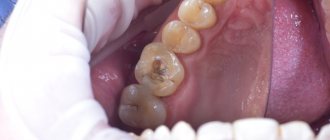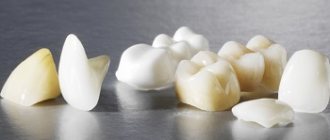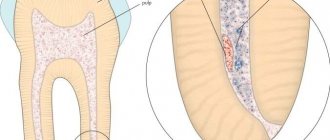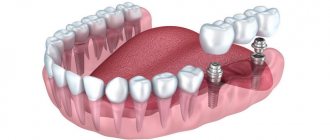Stages and technology
Those barbaric times have long been forgotten when the only way to deal with a bad tooth was to remove it. Progress does not stand still, and perhaps in a few years scientists will come up with some non-contact methods for eliminating damage, however, at the moment, the main treatment for caries is dental filling. Moreover, the better the quality of the material and the more professional the doctor, the longer the damaged tooth will live.
Of course, with such an intervention in the body as filling, pain is simply inevitable, because the nerve endings located in the pulp instantly transmit a signal to the brain about the doctor’s manipulations. Even twenty years ago, dentists used painkillers only in the most extreme cases, which completely turned people away from the desire to treat caries in a timely manner. It was painful, unpleasant and terribly scary. Today, doctors at dental clinics can offer a huge range of anesthetics to choose from, thanks to which the treatment will be painless and unnoticeable.
The filling technology itself consists of several main stages and takes, on average, from half an hour to an hour:
- An injection of an anesthetic that relieves any pain.
- Thorough treatment and cleaning of areas of the tooth affected by caries. In case of pulpitis, the inflamed pulp is also removed and the tooth cavity is completely disinfected. If microscopic areas of the affected tissue remain under the filling, the inflammatory process will begin again with a vengeance.
- If the damage to the tooth surface is not very severe, a simple medical spacer is installed; otherwise, when filling teeth, the treatment technology will include the installation of pins.
- Depending on the location of the damaged tooth and other important factors, the doctor selects the material from which the filling is subsequently installed.
- In order to make sure that the work is done well, as well as that the affected areas are completely eliminated, the doctor takes an x-ray.
- The final stage of the work is grinding the filling composite to eliminate discomfort and coating the filling with indelible varnish. If the grinding is not carried out thoroughly, the patient may have problems chewing food and closing the jaw.
There are situations when the standard stages of tooth filling are not suitable for treating the affected area (canal curvature, filling with a pin and inlay, resection of the root apex). In such cases, so-called retrograde filling is used to prevent further inflammation and hermetically close the canals.
Allergies and side effects
You may be interested in: Removable prosthesis for the lower jaw: types, care features and photos
Modern anesthetics are such that they almost do not cause allergic reactions. As for side effects, some people’s hearts begin to beat faster and tremors appear in their arms and legs. This is how adrenaline works in some painkillers. Some drugs do not contain this substance or contain it in minimal quantities. It is these anesthetics that are injected into children and especially sensitive people.
To avoid unforeseen situations, before performing an injection, the doctor always asks whether the patient is allergic to a particular substance. You need to answer this question extremely honestly.
How painful is it to get a filling? This is not the only issue that concerns patients. Many people are afraid that the anesthesia will stop working prematurely, and then at the end of the treatment it will be painful. It must be said that the duration of action of the injection is different for all people, because it is determined by the speed of blood circulation. For those whose jaws go numb more quickly, the anesthetic does not last very long. However, the doctor always monitors whether painful sensations appear.
Materials
In modern dentistry, a wide variety of materials are used for filling teeth. Since the purpose of filling is not only to close the hole in the tooth, but also to restore its physiological and anatomical functions, the material must be selected according to the load on the tooth and its location.
For example, in case of serious damage to the structure of the chewing tooth, polymers that can withstand heavy loads are used as a filling substance, and for the front teeth it is customary to use light-curing composites, since their properties help to match the color of the filling to the natural color. At the same time, silicophosphate or silicate cements are most often used for incisors.
The basic requirements for materials used to fill canals are as follows:
- complete sealing of root canals;
- absence of a chemical reaction that changes the color of the tooth;
- no shrinkage of the filling;
- easy removal from the dental cavity if repeated treatment is necessary;
- insolubility in the soft tissues of the tooth.
Gutta-percha meets most of the requirements from this list, but has one significant drawback, namely the complete inability of the material to block the vital activity of microorganisms in the sealed cavity. Glass ionomer cements, on the contrary, prevent this process. Not only are they particularly durable, but they are also fully compatible with dental tissues, release fluorides that help strengthen dentin, and do not shrink. When using this material, filling teeth has minimal consequences, however, it also has its drawback - increased acidity. In connection with this fact, a special calcium-based medical pad should be installed under such a filling.
There are other types of filling materials such as pastes, plastics and amalgam. Modern dentistry is trying to avoid the use of amalgam fillings, since they contain mercury, which is very harmful to the body; moreover, this material is not wear-resistant and very unreliable.
Permanent fillings and their types [1,2]
There are many clinical cases that require an individual approach to the selection of material for installing dental fillings. This determines the variety of components used to create a permanent structure, and this determines what types of fillings there are by type of material.
- Amalgams, mercury-based alloys. They are considered the most budget-friendly, very durable and undemanding to installation technology. They are dark with a metallic tint, so they are placed on the chewing teeth , where they are invisible. Fillings of this type are practically not installed on frontal (visible from the outside) teeth due to low aesthetics and a high risk of destruction of the thin tooth wall.
- Cement dental fillings with phosphate and phosphate-silicate additives are more often used as temporary or as an insulating layer under crowns. They are also sometimes installed for permanent use if the most cost-effective option is needed. Despite their low cost, they have good strength and durability for a year or more.
- Glass ionomer cement is strong, adheres well to dentin and enamel, and is structurally similar to dental cement. These types of fillings on the teeth are almost invisible, inert and do not interact with saliva; medicinal additives can be added to them; they are also inexpensive. All this allows the use of this material in pediatric dentistry for the treatment of caries . Patients with these types of dental fillings must carefully follow oral care recommendations and avoid excessively hard foods.
- Synthetic polymer compositions for tooth filling include compomers (composites + ionomers) and ormokers (composites + ceramics). These are chemical fillings consisting of basic and additional components. Additives are necessary to impart certain functional properties, better adhesion (attachment), and increase strength.
- Recent developments include photocurable dental resins. Fillings made from them are durable, invisible, with an average service life of about 10 years. These mixtures cure under the influence of blue light with a wavelength of 480 nanometers, and remain elastic without exposure to such light. During this time, the dentist can choose a shade to match the color of the tooth, form the material into the necessary anatomical shape, and fill all cavities as much as possible.
For fillings that are placed in the so-called smile zone, it is very important to completely match the color of the teeth.
And if not so long ago they selected a suitable shade from a library of colors, today there are multi-color fillings. Like an artist-restorer, the doctor mixes colors, tries them on the working surface and achieves an absolute match in the color of the filling and the tooth. Based on materials from “The influence of plastic processing techniques on the clinical characteristics of composite restorations in the treatment of dental caries,” Ph.D. Medvedeva T. M.
Is it painful to have a filling?
Many readers remember very well from their own bitter experience how toothache was treated in Soviet times. Modern medicine has made giant leaps forward. So, knowing how teeth are filled now, we are no longer so afraid of going to the dentist. This is why the number of people suffering from toothache who are terrified of sitting in the doctor’s chair has been rapidly decreasing in recent years.
Nowadays, a patient in a good clinic is not even faced with the choice of treating a diseased tooth without or with anesthesia, and the choice of anesthetics is so wide that even an allergy sufferer will not have to suffer from pain. A couple of injections into the gums, and for quite a long time the patient does not experience any pain, and a slight sensitivity after filling, which usually goes away within a maximum of two days, can be relieved by modern painkillers or traditional medicine.
Tooth pain after filling in questions and answers
Question: Can a tooth hurt after filling?
Answer:
Yes, especially after depulpation. This is not always a sign of complications, but it is worth seeing a doctor.
Question: What to do after filling a tooth?
Answer:
Follow the doctor’s recommendations and do not subject the treated tooth to heavy loads in the first days.
Question: How long does a tooth hurt after filling (classic)?
Answer:
If your tooth hurts severely for more than a day or two after getting a filling, tell your dentist as soon as possible.
Question: How long does a tooth hurt after root canal filling?
Answer:
In the absence of complications, a period of one to three days is considered normal (excluding severe throbbing pain). If your tooth hurts a week after filling (even if the pain is not too severe), be sure to consult a doctor.
Question: Is it normal to have tooth sensitivity after filling?
Answer:
After therapeutic manipulations, the sensitivity of the tooth may increase, but if after filling the tooth reacts to cold and hot with excessive pain, consult a doctor.
Question: How much can you not eat after filling a tooth with a light filling?
Answer:
It is not recommended to eat food within 1–2 hours.
Question: Why does a tooth hurt after filling when pressed?
Answer:
If there are complications in the form of inflammation and damage to tooth tissue, any mechanical impact will not cause the most pleasant sensations.
Question: What should I do if the tooth is swollen after filling?
Features of filling anterior teeth
Caries of the front teeth is by no means a rare occurrence. The reasons may be poor nutrition, heredity, and lack of proper care. Typically, such caries is a small dark spot, usually on the inside of a tooth or between two teeth, which is even difficult to notice. However, since the dentin layer in the front teeth is very small, such a spot grows rapidly. The main thing is not to miss the moment while the teeth are still amenable to treatment.
When it comes to filling the front teeth, the aesthetic characteristics of the filling substance are placed above the functional ones, since the front teeth bear minimal load during the process of chewing food. That is why light-curing fillings are most often used to treat this type of caries, allowing the natural shape and shade of the enamel to be restored.
There is also a more advanced and expensive way to restore front teeth - ceramic fillings. Outwardly, they do not stand out in any way, so even up close it will be difficult to understand that you are looking at a filling. This material is much more resistant to external influences. True, making a filling from an impression takes quite a lot of time, so this method is usually used only in cases where the tooth is severely damaged and the use of a conventional light filling is impractical.
Pastes for filling
Often, when filling dental canals, a variety of pastes are used. This is one of the filling methods necessary to seal tooth voids after removal of the inflamed pulp. Currently, there are three types of pastes that are most popular; let’s look at their pros and cons.
| Endamethozon paste | One of the best, because it does not dissolve, does not dissolve, does not irritate tooth tissue and remains unchanged. The powder for making this paste comes in two colors: ivory and pinkish-orange. The latter is less preferable because it changes the color of the enamel over time. |
| Forfenan paste | During polymerization, it becomes very hot and releases formaldehyde, which turns the pulp into a solid, antiseptic substance. The only negative point in using this type of paste is the long hardening process. |
| Formalin paste Resorcinol | The disadvantage of this substance is its effect on tooth color. Over the years, the natural color changes to a completely unattractive appearance, so it is not recommended to use it on the front teeth. However, the use of this paste is quite widespread and has been proven over the years. |
There are also general disadvantages of all types of pastes: it is quite difficult to unfill a tooth during repeated treatment, the density of the material when filling the canal is distributed unevenly, and there is a high risk of air gaps forming in the hardened paste. And, nevertheless, filling tooth cavities with paste remains the most popular today.











